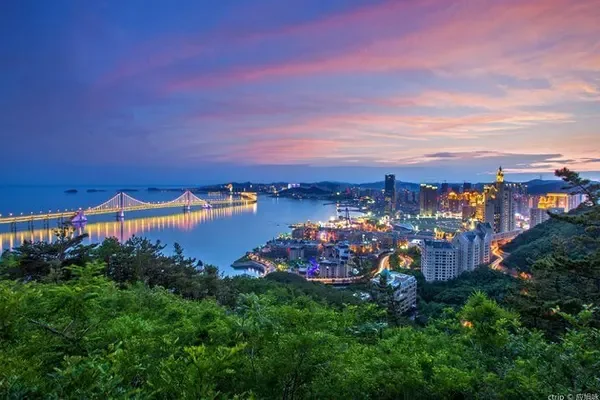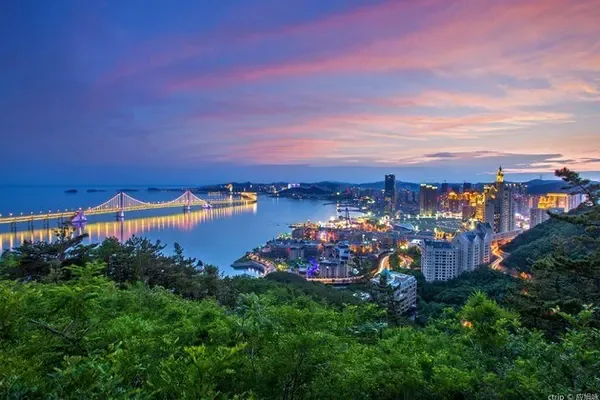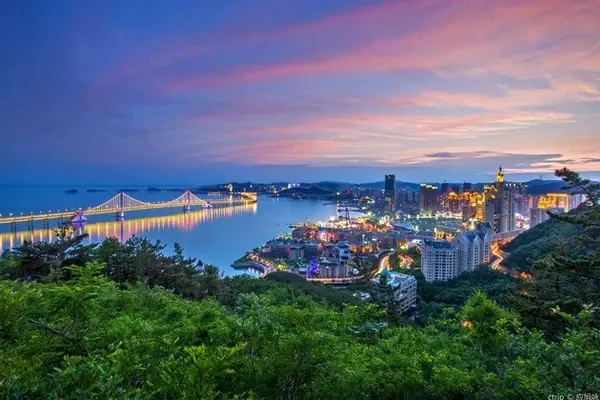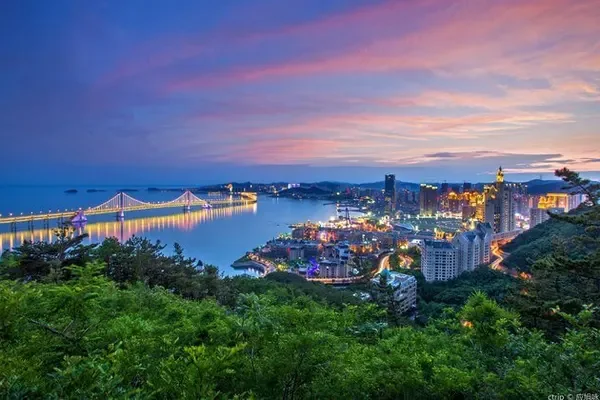There is a famous 109 National Highway to the west of Beijing, which is actually the Beijing section of 109 National Highway. Because, National Highway 109 was built in 13 years from 1942 to 1954. It is a road that carries on a heavy history like the US Route 66. National Highway 109 connects the Forbidden City and the Potala Palace, with a drop of 5,000 meters from the plain to the plateau. She passed through high mountains and canyons, Loess Plateau, grassland Gobi, basin rivers, crossed Kunlun Mountains, Fenghuoshan Mountains, Tanggula Mountains, and Nyainqentanglha Mountains, crossed the Yellow River, Tongtian River, Chumar River, Tuotuo River, and traversed the east and west of China. oo. National Highway 109 not only witnesses the modern history of China, but also symbolizes the pioneering spirit of the Chinese people and their optimism and perseverance in the face of difficult situations. Simply put, it's a great path.
The Beijing section of National Highway 109, from Fuchengmen to the west, is a golden tourist channel that runs through Mentougou in the west of Beijing, and is one of the best tourist routes in Beijing. The geographical environment along the line is changeable, mostly mountainous and hilly areas, with winding mountain roads, rich vegetation, many streams and rivers in the mountains, and beautiful scenery. The main tourist attractions that can be reached along the way are Miaofeng Mountain, Eighteen Pools, Pearl Lake, Lingshui Juren Village, Cuandixia, Huangcaoliang, Longmenjian, Baihua Mountain, Lingshan Mountain, etc.
And we chose the theme of ancient village tour. This time, we selected three ancient villages with different styles: Sidamo Village, Cuandixia Village and Lingshui Village. What they have in common is that they are surrounded by mountains and have a long history of humanities. Of course, there are also differences. Different landscapes, different cultural landscapes, and different cultural backgrounds.
Let's introduce them one by one in the order of our walking:
Sidamo Village:
Sidamo Village is located in Qingshui Town, which has rich coal resources. In recent years, all coal mines have been closed in accordance with the development orientation of Mentougou District's ecological conservation area, and relying on the advantages of natural location, it has vigorously developed the high-end homestay tourism industry and carefully built a characteristic tourism brand. In addition to the most common sumac and ingot maple, there are also golden ginkgo, red and yellow torch trees, dark brown silver red maple, deep red pistachio, etc., which together form a colorful, emerald green and gold "red leaf" The "landscape" painting, shining in the sun, strongly impacts the vision of tourists.

The red leaves are all over the mountains, the forests are all dyed, and the red maple welcomes autumn


Here you can see "colorful oil paintings" expressed in different colors


A small village surrounded by red leaves


"Observation Deck"

Various colorful vegetation all over the mountains and plains

From the village, you can climb up the "observation platform" along a small road, and you can also drive directly to the mountain when there are few people. But the premise is that when there are few people, because the road up the mountain is not very wide, if there are many people and vehicles, the road up the mountain may be blocked, which may lead to a dilemma. There were not many people when we went, but we still chose to hike. First, the mountain is not high; second, I still hope not to miss the scenery along the way.









Sidamo Village surrounded by mountains seen from a high place


Altar of Master Bodhidharma


Master Bodhidharma guards the mountains and looks at the "observation platform"


It is very convenient to travel along National Highway 109-Qingshui Town-Sidama Village from the urban area. There is no scenic spot ticket, but a sanitation fee of 10 yuan per car

After leaving Sidamo Village, go to the next scenic spot "Cuandixia Village".
Cuandixia Village is located in Zhaitang Town, Mentougou District in the western suburbs of Beijing, 90 kilometers away from Beijing, 650 meters above sea level, and the village area is 5.3 square kilometers. The Qingshui River basin has good natural vegetation and is suitable for raising sheep and bees. Under Cuan is a national A-level scenic spot. : Cuandixia Gushan Village is a pearl of Chinese classical architectural treasures. It contains profound connotations of northern architectural culture. In terms of its history, cultural and artistic value, it is not only in Beijing, but also in the whole country.

"Cuan" originally means stove. When this mountain village was built, the owner named it "Cuan Dixia", which means to avoid the severe cold, which may have the meaning of refuge, and the implication of viewing the scenery makes people feel like a paradise.




Cuandixia Village faces south and is built on a gentle slope with layers of elevation. It is built along the mountain, and according to the situation, each house has the best lighting, ventilation, and visual effects, fully embodying the relationship between people and buildings. The perfect combination with the environment.





Old gray tile cornices

Cuandi people focus on farming and reading, and also pay attention to Fengshui. The surrounding environment of the village is in perfect harmony with Fengshui theory




The structure of the whole village is rigorous, and the courtyards are well-proportioned and well-organized. The layout is reasonable. The architectural style not only has the details of windows, buildings, and rooms in the south of the Yangtze River, but also the charm of local treatment, as well as the grand overall momentum of the northern high-rise courtyard. The courtyard walls with gray tile cornices and stone barriers are dignified and thick, revealing majesty, calm and peaceful, and profound culture accumulated. It is called "the Potala Palace in the west of Beijing".


On the left of Cuandixia Village, there are Inner Qinglong Mountain, Dongpoliang, Outer Qinglong Mountain, and Xieyu Dongpoliang. The two Qinglong Mountains are majestic and undulating, and the most amazing thing is that the inner Qinglong Mountain raises three groups of hills amidst the ups and downs, resembling three auspicious animals. That is: crouching tiger, lying on the side of the head and looking at the whole village, the tiger, the king of beasts, is the salary. The tortoise, the god tortoise screams at the sky, raises its head to the sky and screams, the tortoise is for longevity. Bats send blessings, flying here, bats, for blessings. Fu Lu Shou Xing shines on the ancient village.

The houses and courtyards in Cuandixia Village are very particular from an architectural point of view, but for us laymen, we can only watch the excitement







About 3 kilometers north of Cuandixia Village is Xiaobeigou Valley, which is known as the "one line of sky" in the west of Beijing. The locals call it Cuandi Ankou. It is integrated with the village, like the neck of a treasure gourd, protecting this remote village.

At 2:30 in the afternoon, we left Cuandixia Village. After driving for more than 30 minutes, you can reach "Lingshui Village".
Lingshui Village in the mountain depression is quiet and serene. This mountain village located on the ancient post road in the west of Beijing is full of wind and energy, covered with pines and cypresses, and clear springs surround the village. During the Ming and Qing Dynasties, there were 22 Juren and two Jinshi in Lingshui Village. In the early years of the Republic of China, 6 people graduated from Yenching University. This is really an anecdote for a small village closed deep in the mountains with only a few hundred people.



The architectural layout of Lingshui ancient village is just like the tortoise in the traditional culture "Four Spirits". According to legend, "Lingshui" originated from this. The old people said that looking down from the Guanyin Bodhisattva Temple at the south end of the village, the south tower is the head of the tortoise, the north temple is the tail of the tortoise, the Longwang Temple and Lingquan Temple in the west of the village, Mawang Temple and Wenchang Pavilion in the east of the village are the tortoise's tail. four legs, and the courtyards in the villages are just like the pattern on the back of a turtle.


There is a group of sculptures in the "Cultural Square", which is very interesting. Describes "studying hard in the cold window", going to Beijing to rush for the exam, strict teachers and apprentices, the time of winning the exam, etc.











In this small village on the outskirts of the mountains, Buddhism, Taoism, Confucianism, and Catholicism coexist, creating a unique religious culture. Lingquan Temple "began in the Han Dynasty" and was the earliest temple in Beijing, and now only the mountain gate remains. There are 17 temples scattered in the village, including the Niangniang Temple, Nanhai Huolongwang Temple, Wenchang Pavilion and Kuixing Tower. Outside the village is a Catholic church built in the Yuan Dynasty.

Two dioecious ancient ginkgo trees in Lingquan Temple

Ancient locust tree in Lingquan Temple

Follow this path from Lingquan Temple to the South China Sea Fire Dragon King Temple

The sacred tree spirit tree is another unique feature of Lingshui Village. There are two thousand-year-old towering ancient cypresses "Baibaoyu" and "Baibaosang" in the Fire Dragon King Temple in the South China Sea.

This is a 1,800-year-old cypress identified by the Chinese Academy of Sciences

In front of the Longwang Temple in Lingshui Village, there is an octagonal dragon pond, which is a place where villagers share spring water. In order to protect the water source, during the Kangxi period of the Qing Dynasty (1691), the villagers jointly set the rules and engraved a stele next to the pool: "Three prohibitions in the pool: fierce throwing and jumping, foolish mixing, and children drowning in sweat. Three prohibitions in the pool and platform: slaughtering fishy smell, drinking Raising animals, starching clothes and washing vegetables." This "Three Prohibition Monument" is also the earliest physical evidence of water protection in Beijing.

ancient stage



Although some houses in the village have not had "juren" or "jinshi", they still have a certain flavor.



The unadorned simplicity and the cultural atmosphere accumulated over thousands of years have attracted many film and television dramas to Lingshui Village for filming. The movie "Favorite", the TV series "Bright Sword" and "Scent of Sophora Blossoms in May" were all filmed here. A certain compound that passed by inadvertently may have lived in a famous celebrity. The crew of "Where's Dad?" also lived and filmed here


This is "One School and Five Judgments", a relatively large courtyard in the village, and it is famous for the five brothers who all passed the examination. It looks like a casual small door, but after entering it, there is something hidden in the sky. After entering the courtyard, each entry is higher than the next, until it reaches a high platform.

Is Wujuren's courtyard different from what I imagined?



Near the Wudao Temple in the north of the village, there is a thousand-year-old cypress tree with a flat crown and horizontal branches. It slopes eastward according to the terrain, just like Ganoderma lucidum, also known as "Ganoderma lucidum cypress".

The whole village has the custom of "drinking autumn porridge together", which has been passed down for 300 years. Liqiu is here on this day. People in the village sell rice and grain, and others sell miscellaneous beans. They set up pots and firewood on the street. This is not only to commemorate the ancestors who donated food for disaster relief during the catastrophe, but also to promote harmony among neighbors and eliminate previous estrangements.

In one day, if you are nervous, you can walk through three ancient villages with different styles. Not to mention being nervous, I didn't leave "Lingshui Village" from 6:30 in the morning until almost 6 in the afternoon. When the car drove to the "Yongding Building" in Mentougou, it was completely dark. It can be said that today is a very fulfilling day, a very eye-catching day, and a day of gaining knowledge.



